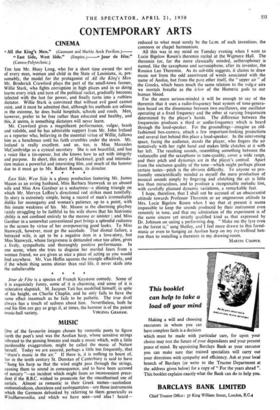MUSIC
ONE of the favourite images chosen by romantic poets to figure forth the poet's soul was the Aeolian harp, whose sensitive strings vibrated to the passing breezes and made a music which, with a little pardonable exaggeration, might be called the music of Nature herself. Today we are assured, perhaps a little too frequently, that " kliere's music in the air." .If there is, it is nothing to boast of, for in the tenth century St. Dunstan of Canterbury is said to have " hung his harp so that the wind might pass through the strings, causing them to sound in consequence, and to have been accused of sorcery "—an incident which might form an inconvenient prece- dent if the B.B.C. wished to prosecute for the unauthorised use of aerials. Almost as romantic in their Greek names—aeolodion aeolomelodicon, choraleon and aeolopantalon—are those instruments which the Germans debunked by referring to them generically as Windharmonika, and which we have seen—and alas ! heard—
reduced to what must surely be the l.c.m. of such inventions, the common or chapel harmonium.
All this was in my mind on Tuesday evening when I went to Lucie Bigelow Rosen's theremin recital at the Wigmore Hall. The theremin (or, for the more classically minded, aetherophone) is named, like the saxophone and sarrusophone, after its inventor, the Russian Leo Theremin. As its sub-title suggests, it claims to draw music not from the odd assortment of winds associated with the name of Aeolus, but from the pure ether itself, the " upper air " of the Greeks, which bears much the same relation to the vulgar airs we mortals breathe as the ichor of the Homeric gods to our human blood.
For the more serious-minded it will be enough to say of the theremin that it uses a radio-frequency beat system of tone-genera- tion based on the dissonance between two oscillators, one oscillator operating at a fixed frequency and the other at varying frequencies determined by the player's hands. The difference between the frequencies produces a third or audio-frequency which is heard through the loud-speaker. For the groundlings—imagine an old- fashioned box-camera, attach a few important-looking projections and several feet behind this place a loud-speaker. In the intervening space, facing the audience, stands the player, who fingers the air tentatively with her right hand and makes little clutches at it with her left. The resulting sounds, resembling something between the violoncello and the saxophone in tone-quality, cover a wide range, and their pitch and dynamics are in the player's control. Apart from the unctuous quality of the tone—which might perhaps please certain tastes—pitch is the obvious difficulty. To anyone so pro- foundly unscientifically minded as myself the mere production of musical sounds simply by fingering and clutching the air is little less than miraculous, and to produce a recognisable melodic line, with carefully planned dynamic variations, a remarkable feat.
I hope, therefore, that I shall not be accused of an obscurantist attitude towards Professor Theremin or an ungenerous attitude to Mrs. Lucie Bigelow Rosen when I say that at present it seems impossible to keep the sounds produced by their instrument even remotely in tune, and that my admiration of the experiment is of the same sincere yet strictly qualified kind as that expressed by Dr. Johnson on seeing a performing dog. " Make me thy lyre even as the forest is," sang Shelley, and I feel more drawn to this forest- music or even to hanging an Aeolian harp on my ivy-trellised hen- run than to installing a theremin in my drawing-room.
MARTIN COOPER..






































 Previous page
Previous page